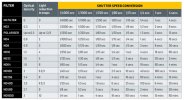- Joined
- Jun 21, 2020
- Messages
- 3,977
- Reactions
- 3,962
I have been a huge fan of gradient ND filters since I purchase a set of PolarPro graduated ND filters for my Mavic 2 Pro. I don't think I've used a regular ND filter since getting them. We all know that regardless of how we set our exposure, if we have sky and ground in the same shot, most of the time the sky will be brighter than the ground making optimal exposure setting difficult. I've found that even when there is only ground, the gradients are so subtle, if you notice it a all it's like a vignette more than an exposure issie. I'm waiting for someone else to make a decent gradient ND filter.
I see that Freewell is now making a soft edge gradient ND filter. They look interesting. But will they do the job that standard ND filters do? I'm just having trouble deciphering what the ND descriptions are. One is listed as GND0.9 and the other is GND 1.2.
What do those designations mean in actual neutral density?

I see that Freewell is now making a soft edge gradient ND filter. They look interesting. But will they do the job that standard ND filters do? I'm just having trouble deciphering what the ND descriptions are. One is listed as GND0.9 and the other is GND 1.2.
What do those designations mean in actual neutral density?












